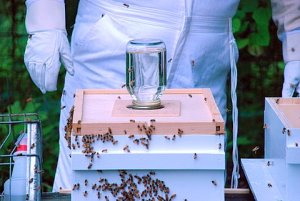Feeding the Bees
When there isn’t a lot of food available, a beekeeper will provide food for the hive. In order to provide food, a beekeeper gives the hive imitation nectar, which is sugar water; the beekeeper mimics pollen by giving the bees protein paddies. Protein paddies, also referred to as “pollen substitutes” are supplied by four major companies in the United States, “Bee-Pol®, Bee-Pro®, Feed-Bee®, and MegaBee®. It appears that Bee-Pro® is soy-based, and Feed-Bee® and MegaBee[®] are non-soy-based”. The author doesn’t have information on “Bee-Pol®” (Huang, 2010). With the beekeeper providing food, it ensures that the bees will not starve during lean times.


Her Majesty’s Army
 There are other worker bees besides the ones who build the house and care for the young. The “workers, … are all non reproducing females” (tamu.edu). One type of worker is field bees, which busily float on the wind from flower to flower extracting sweet nectar and pollen for the bee family as they go. With the nectar in their bellies and the pollen holstered on their legs, the bees return home. These bees are usually the oldest workers in the colony (Burns, 2010, p. 32). Bee experts can tell this because of the amount of ware and tear that their wings show (p. 40). When workers are able to make wax, they take “on building and repairing of the honeycomb” in the house (p. 32). When a worker is able to fly around a little, she is “able to make honey” and “guard the hive”. These bees receive the groceries of nectar and pollen from the field bees and then they package these groceries in honeycombs, when the groceries becomes ripe, they seal it up in wax (p. 32). The male honey bees do nothing other than mate with the queen. The male honey bees, or drones have no stinger, and rarely leave the hive; they only survive until winter (tamu.edu).
There are other worker bees besides the ones who build the house and care for the young. The “workers, … are all non reproducing females” (tamu.edu). One type of worker is field bees, which busily float on the wind from flower to flower extracting sweet nectar and pollen for the bee family as they go. With the nectar in their bellies and the pollen holstered on their legs, the bees return home. These bees are usually the oldest workers in the colony (Burns, 2010, p. 32). Bee experts can tell this because of the amount of ware and tear that their wings show (p. 40). When workers are able to make wax, they take “on building and repairing of the honeycomb” in the house (p. 32). When a worker is able to fly around a little, she is “able to make honey” and “guard the hive”. These bees receive the groceries of nectar and pollen from the field bees and then they package these groceries in honeycombs, when the groceries becomes ripe, they seal it up in wax (p. 32). The male honey bees do nothing other than mate with the queen. The male honey bees, or drones have no stinger, and rarely leave the hive; they only survive until winter (tamu.edu).
How Honey Bees Make Honey
 Honey bees busily float on the wind from flower to flower extracting sweet nectar and pollen as they go. With the nectar in their bellies and the pollen holstered on their legs, the bees return home. At home, the field bees unload their groceries into the bellies and on the legs of the receiver bees. The receiver bees carry the fresh “produce” deep into their home and pack it away in their pantry. After sitting in its storage cabinet for a while, the honey ferments and it is ready to be preserved with a layer of bee’s wax. The bee’s wax can be easily removed by the bees when they need to get to their food, unless a beekeeper gets to it first…
Honey bees busily float on the wind from flower to flower extracting sweet nectar and pollen as they go. With the nectar in their bellies and the pollen holstered on their legs, the bees return home. At home, the field bees unload their groceries into the bellies and on the legs of the receiver bees. The receiver bees carry the fresh “produce” deep into their home and pack it away in their pantry. After sitting in its storage cabinet for a while, the honey ferments and it is ready to be preserved with a layer of bee’s wax. The bee’s wax can be easily removed by the bees when they need to get to their food, unless a beekeeper gets to it first…
leave a comment